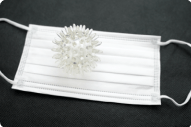
*1 Ideal mask based on a survey of 1,000 medical professionals (based on Shionogi Healthcare survey data on “areas of dissatisfaction” and “essential features”)
To protect your loved ones, start by protecting yourself.
Shionogi Healthcare focused on masks.
High capture performance and comfort that can be worn for a long time
Combining these two features,
a high-performance mask that realizes
the ideals of medical professionals has been developed.
Wear a reliable mask for protection against unavoidable risks.
Pylon PL Pro Mask,
produced by Shionogi Healthcare, in constant battle against infections
- Three-dimensional type
- Pleated type
Pro design that combines high functionality and comfort
Original structure to achieve spaciousness,
lightness, and fit
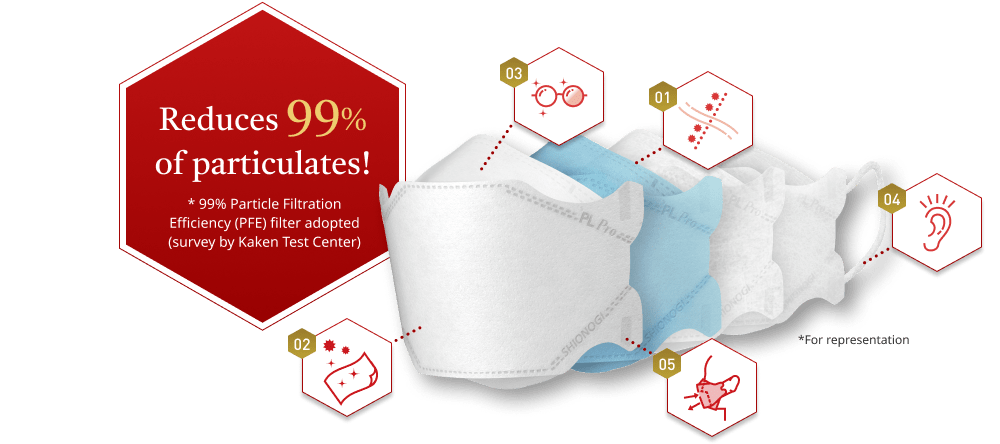
Safe and secure
ultra-lightweight technology

Ultra-fine nanofiber material
Nanofiber material “NafiaS,” jointly developed by Shinshu University and NafiaS Inc., is used for the second layer of non-woven fabric.
Breathability is ensured while capturing particulates of 0.1 μm in size, which is far finer than pollen and PM2.5. The structure is less likely to produce stuffiness, facilitating breathing and talking.
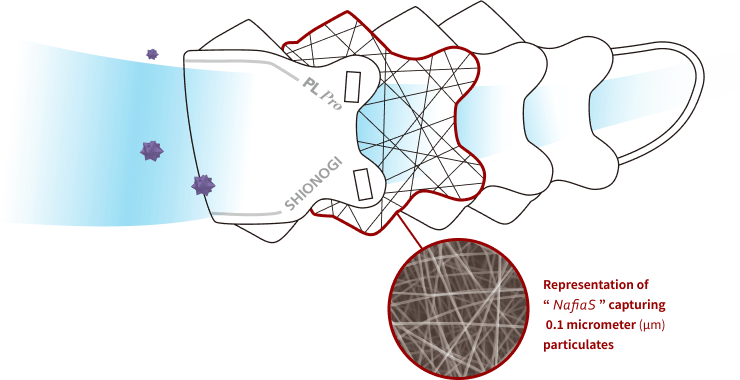
About 
A nanofiber commercialized by joint development via collaboration between a company and Shinshu University, which has the only faculty of textile science and technology in Japan.
Its nanoscale diameter is 100 nanometers (nm).
Purple, which is said to be the shortest wavelength of light visible to the human eye, is 380 nm.
Since 
Comparison with
a conventional filter
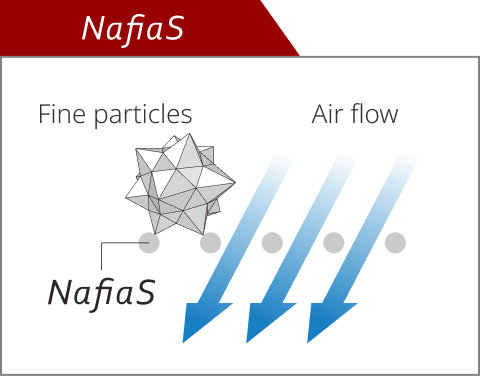
The fiber diameter secures a space for air flow while capturing particulates. Since particulates are captured on the surface, filters are less likely to become clogged.
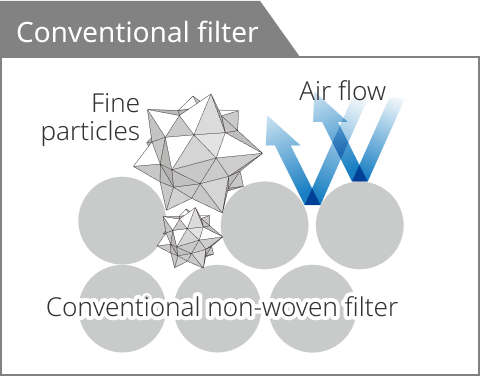
Since the fiber diameter is large, it blocks the space for air flow. Also, if particulates do find their way into the filter gap, they become clogged.
Material size and
filter fiber diameter

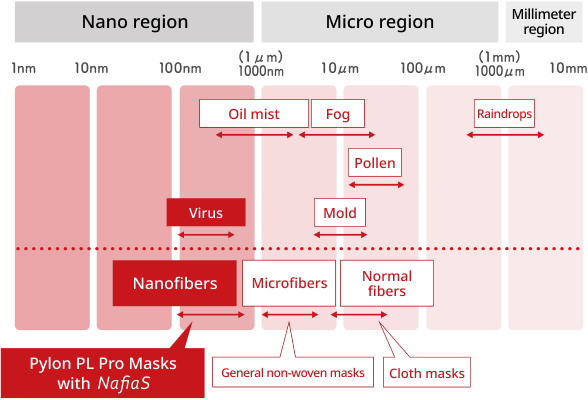
View details

Antiviral and antibacterial/deodorizing double-protection processing
“Antiviral processing,” reducing the number of specific viruses on the fiber, and “antibacterial/deodorizing processing,” suppressing the growth of bacteria on the fiber and exhibiting a deodorizing effect, are provided on one sheet of non-woven fabric. The product demonstrates a high particulate capturing effect while realizing both a four-layer three-dimensional structure and thinness at the same time. Furthermore, the product provides increased breathability.
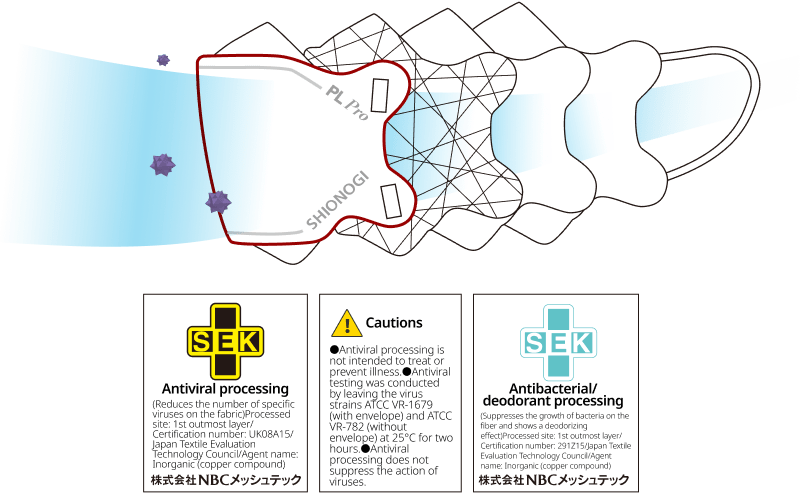

Anti-fog tape
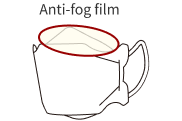
It incorporates a film (anti-fog tape) that suppresses airflow toward the glasses, giving it a stylish look.

Soft stretch ear bands
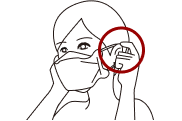
Wide and soft ear bands are used to reduce strain on the ears.

Achieves a comfortable spaciousness around the mouth.
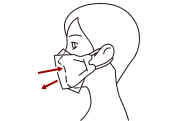
The three-dimensional shape secures a wider space around the mouth. The structure provides higher breathability and less stuffiness.

Carefully thought-out
specifications to achieve a snug fit
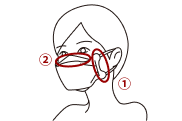
Concave shapes are used for the cheeks (①), and a nose fitter with high shape memory is used for the nose back (②). Such specifications enhance the fit and prevent gaps.
How to wear a mask appropriately
If worn incorrectly, the mask may not be able to provide the full effect. When you wear a mask, check the following steps to ensure that there are no gaps between your face and the mask for appropriate use. For maintenance of functionality and hygiene reasons, we recommend using one mask per day.
STEP1
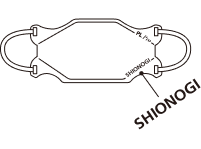
Check the front and back. The side with the “SHIONOGI” mark should come outward.
STEP2
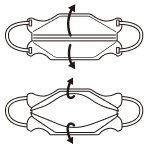
Open upward and downward and place the ear bands to fit your face.
STEP3
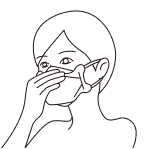
Shape the nose fitter to fit the shape of your nose.
STEP4
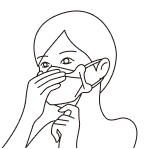
Stretch the top and bottom of the mask and adjust to fit your face.
STEP5
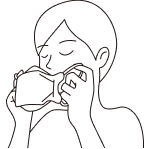
After use, remove the mask, making sure not to touch the surface.
STEP6
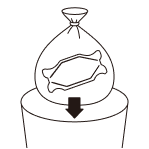
Place the mask in a plastic bag, seal it, and throw it in a trash box.
STEP7
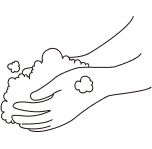
Make sure to wash your hands with soap after disposing of the mask.
Pro design that combines high functionality and comfort
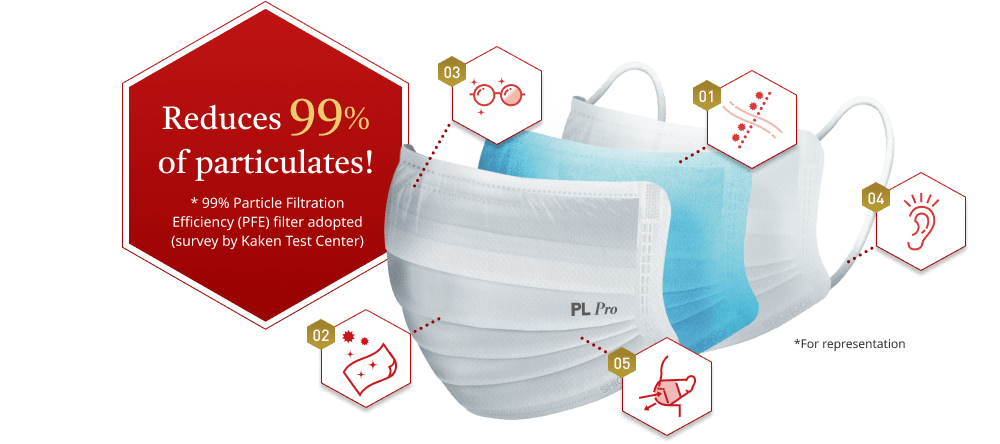
Safe and secure
ultra-lightweight technology

Ultra-fine nanofiber material
Nanofiber material “NafiaS,” jointly developed by Shinshu University and NafiaS Inc., is used for the second layer of non-woven fabric.
Breathability is ensured while capturing particulates of 0.1 μm in size, which is far finer than pollen and PM2.5. The structure is less likely to produce stuffiness, facilitating breathing and talking.
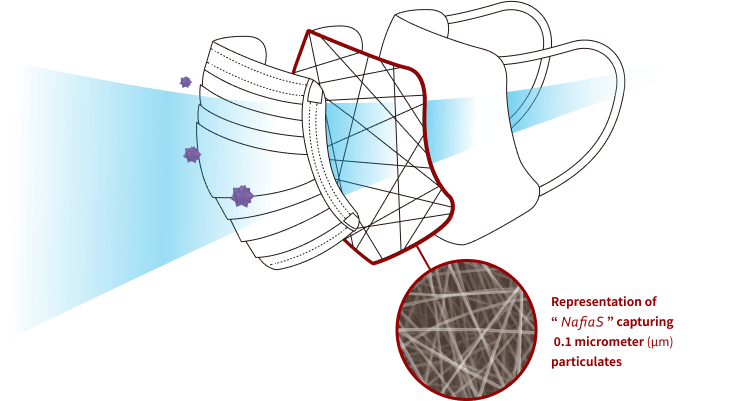
About 
A nanofiber commercialized by joint development via collaboration between a company and Shinshu University, which has the only faculty of textile science and technology in Japan.
Its nanoscale diameter is 100 nanometers (nm).
Purple, which is said to be the shortest wavelength of light visible to the human eye, is 380 nm.
Since 
Comparison with
a conventional filter

The fiber diameter secures a space for air flow while capturing particulates. Since particulates are captured on the surface, filters are less likely to become clogged.

Since the fiber diameter is large, it blocks the space for air flow. Also, if particulates do find their way into the filter gap, they become clogged.
Material size and
filter fiber diameter


View details

Antiviral and antibacterial/deodorizing double-protection processing
“Antiviral processing” reduces the number of specific viruses on the fiber, and “antibacterial/deodorizing processing” suppresses the growth of bacteria on the fiber and exhibits a deodorizing effect.
These two types of processing are often applied separately to each non-woven fabric, and it is common to have a four-layer structure to make a mask that has both types of processing. The Pylon PL Pro mask has achieved a thinness of three layers while exhibiting a high particulate-capturing effect, by applying two types of processing on a single non-woven fabric. This also provides increased breathability.
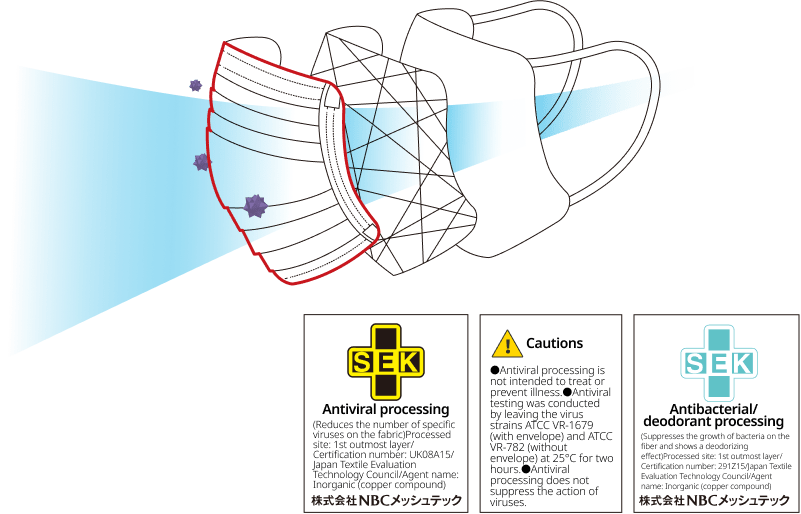

Double anti-fog tape
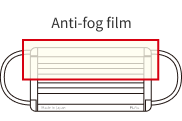
The film applied to both sides of the mask suppresses the airflow toward the glasses.

Soft stretch ear bands
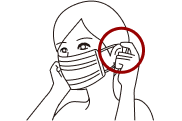
Wide and soft ear bands are used to reduce strain on the ears.

Triple omega pleats
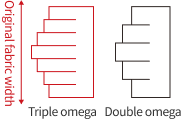
The product is designed to have three layers of pleats. This structure expands the original fabric width and provides a wider space around the mouth with increased breathability.

Mark to identify front or back
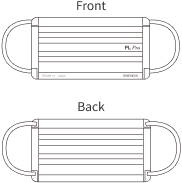
An easy-to-notice mark allows you to identify the front or back, thereby helping users to wear the mask appropriately.
How to wear a mask appropriately
If worn incorrectly, the mask may not be able to provide the full effect. When you wear a mask, check the following steps to ensure that there are no gaps between your face and the mask for appropriate use. For maintenance of functionality and hygiene reasons, we recommend using one mask per day.
STEP1
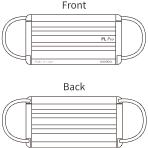
Check the front and back. The side labeled “inside” is the back.
STEP2
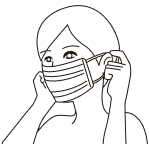
Make sure that your mask fits on your face, and place the ear bands on your ears.
STEP3
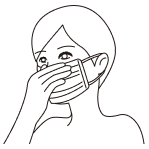
Shape the nose fitter to fit the shape of your nose.
STEP4
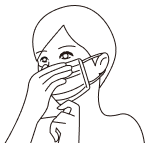
Spread the pleats upward and downward according to the size of your face.
STEP5
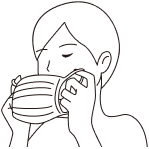
After use, remove the mask, making sure not to touch the surface.
STEP6
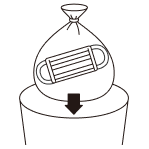
Place the mask in a plastic bag, seal it, and throw it in a trash box.
STEP7

Make sure to wash your hands with soap after disposing of the mask.
Shop now
 Visit a store
Visit a store
Today, people select masks
by risk.
An independent survey conducted by Shionogi Healthcare
revealed that more than 60% of people already select masks according to the situation.
Masks have become an integral part of our daily lives.
Become familiar with the difference between types and functions, and
select masks wisely and effectively.
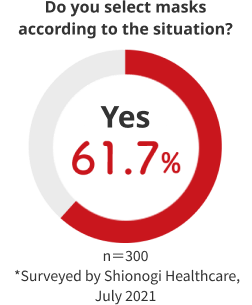
Low
Risk
High
During outdoor activities
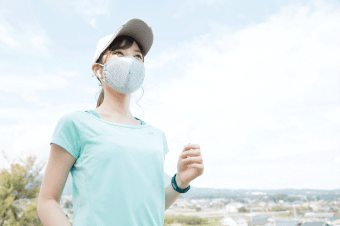
For outdoor activities where you can keep a sufficient distance from other people (approximately two meters or more away), use of a mask is not required as a rule. When using a mask, a breathable urethane mask and a washable cloth mask will do.
Compared to non-woven fabric masks, urethane masks and cloth masks have the disadvantage of weak filterability, but they have higher breathability and are less likely to cause heatstroke. In addition, they are available in a wider range of colors and designs to be selected according to the situation and mood.
When going out to a non-crowded indoor place

For going out to indoor places, use of a general non-woven mask is recommended.
Moderate filterability and affordable price are suitable for frequent outings. If you can keep a sufficient distance from other people (approximately two meters or more away) and have few or no conversations, use of a mask is not required.
When going out to a crowded place
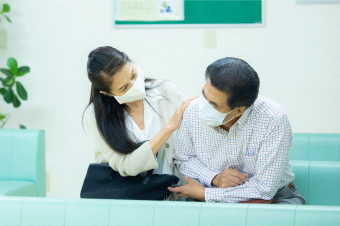
Select a high-performance mask when going out to places where you may come in close contact (at a distance of approximately less than two meters) with people, such as hospitals, public transport, such as trains or buses, or where there are crowds.
In particular, nanofiber non-woven masks that can remove even minute viruses for a long time are effective. Also, wear a high-performance mask to protect your loved ones and people around you when you are not feeling well.
The Pylon PL Pro Mask
comes in hygienic, portable individual packaging.
Carry one in your bag for your safety in case of emergency.
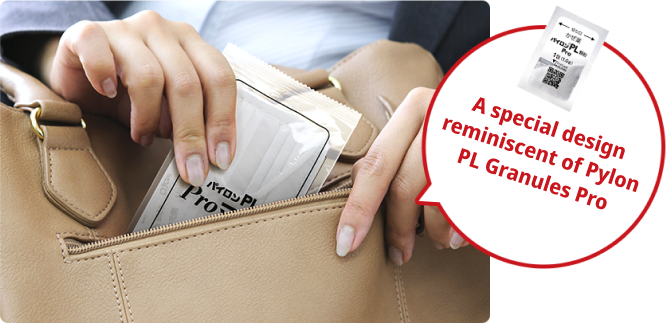
Basic knowledge of masks that you should know
Development background
The reason Shionogi Healthcare developed masks
“In order to reduce the risk of infection, it is necessary to take various measures across multiple layers.
As a countermeasure against infectious diseases, we develop products and services based on the concept of ‘multi-layered defense.’* The development of masks is one of them.
With COVID-19, masks have become a part of our lives, and new needs seem to have emerged. In fact, when we conducted a survey of medical professionals and general consumers, we found there were unmet needs, especially in terms of functionality (antivirus/antibacterial) and convenience (breathability). To solve these problems, we decided to develop a mask.”
* 6 principles: “correct information,” “building a strong body,” “environmental hygiene,” “hand washing/gargling,” “coughing/etiquette,” and “diagnostic treatment model”
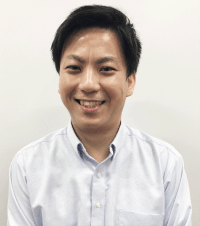
Mask Development Responsible Person,
Shionogi Healthcare Co., Ltd.
The concept is “to provide a medical professionals’ ideal mask to everyone”
“There are so many masks with various functions and shapes on the market that it seems people do not know which one to choose. Therefore, we decided on this concept to incorporate into the masks the needs of medical professionals, who are experts in infectious diseases, and to provide such masks to general consumers.
In the previous survey, we found that there was demand for non-woven fabric masks that are both functional and convenient, so we started by selecting materials to meet those needs.”
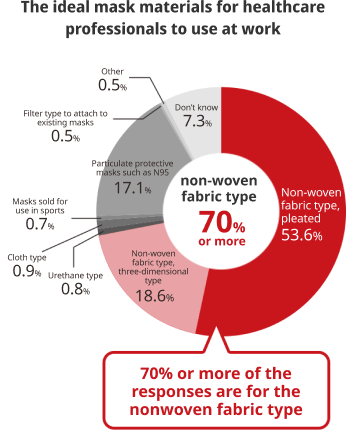
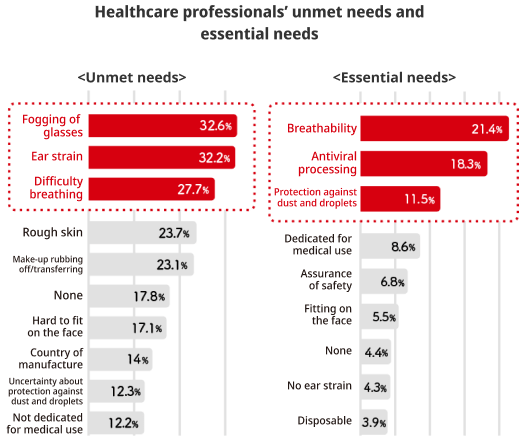
* Surveyed by Shionogi Healthcare, December 2020,
on healthcare professionals n=1,000
Fight to lower the risk of infection
“The hardest part of developing the mask was balancing functionality and convenience (breathability). A typical mask simply captures viruses and bacteria, and if you touch a contaminated mask and then touch your nose, mouth, etc., the risk of infection remains high. Our company’s goal is to reduce the risk of infection as low as possible, so in order to develop a mask that can prevent secondary infections, adding antiviral and antibacterial effects was a must.
However, usually when you try to increase the functions, you also need to increase the layers of non-woven fabric sheets, reducing the mask’s breathability. Masks are things we use every day, so no matter how functional they are, they are meaningless if they are difficult to use. Therefore, as a result of repeated trials and reviews using various materials and raw fabrics, we succeeded in adding antiviral and antibacterial functions to a single non-woven fabric. We were able to achieve maximum functionality with minimum thickness.”
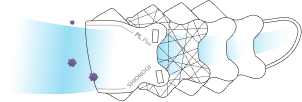
Try the mask on.
“However, it is difficult to convey the capturing function and breathability in words, so do try this product on and experience the effects.”
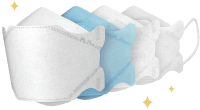
The Pylon PL Pro mask is safe,
high quality,
and made in Japan.
All Pylon PL Pro masks are manufactured in our domestic plants.
Under thorough hygiene control making use of the knowledge and findings of a pharmaceutical company, we use carefully selected materials and carry out consistent quality control from design to manufacturing. We deliver high quality and assurance of safety. The product is also recommended as a gift to your loved ones.
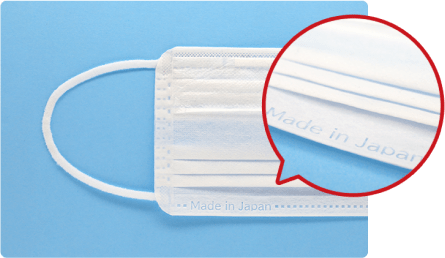
Q&A
Can the masks be washed and reused?
As this is a disposable product, we do not recommend washing the masks for reuse. To maintain the product’s functionality and hygiene, wear one mask per day as a general rule.
How long can the mask be used after opening the package?
For hygiene reasons, use the mask as soon as possible after opening the package.
Is there use-by date?
There is no specified use-by date, but we recommend that you use it as soon as possible after purchase. Avoid storing masks in places with high temperatures, humidity or direct sunlight.
Can pollen and other particulates be completely blocked?
Pollen particles are generally between 10 and 100 μm in size. This product is “PFE99%,” so it filters (captures) 99% of particles of about 0.1 μm in size.
How effective is this product in preventing colds?
The effect on the cold itself has not been confirmed. This product is “PFE99%,” so it filters (captures) 99% of particles of about 0.1 μm in size. If you wear this mask properly, the entry of most of the droplets produced by coughing and sneezing can be blocked.
What are omega pleats?
There are two types of pleated masks, depending on the direction of the pleats. The first type is the “staircase type,” in which pleats are from top to bottom. The second type is the “Omega type,” in which pleats are directed upward and downward from the center. This product is an Omega type, and it is a “Triple Omega type” with three layers of pleats. Compared to the “Double Omega type,” the space around the mouth is wider.
From what age can this product be used?
The Pylon PL Pro mask comes in three types in the sizes as described below.
<Pleated type> Normal size: 175 mm x 90 mm; small size: 160 mm x 90 mm.
<Three-dimensional type> 190 mm x 90 mm.
Although there is no minimum age for starting to use this product, do not use this product on infants. Regardless of age, when you use this product, wear this product correctly so that there are no gaps between your face and the mask. If there is a gap, the size of the mask does not match your face, so use a mask of a size that suits you.
Product lineup
-
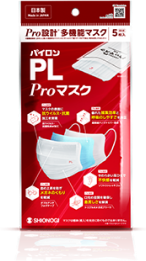
5 pieces
-
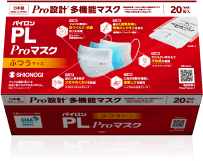
20 pieces
-
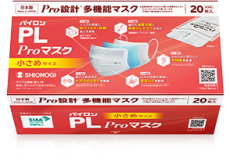
20 pieces
Pleated type
-
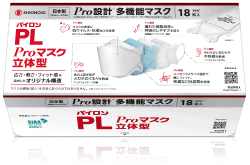
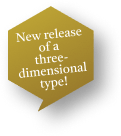
18 pieces
Three-dimensional type
Shop now
 Visit a store
Visit a store
About mask weight
3 g or less per mask Light enough to feel the difference!
The Pylon PL Pro mask uses nanofiber and provides antiviral and antibacterial/deodorizing double-protection processing, and yet it weighs only about 2.9 g. It is so comfortably light that it makes you unaware that you are wearing a mask.
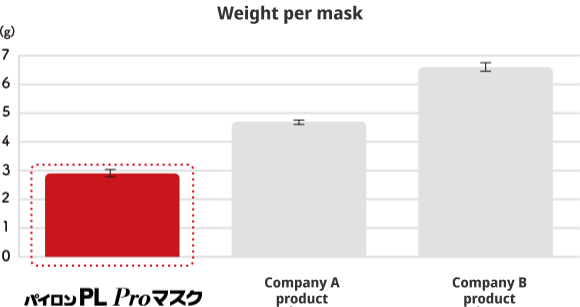
* The black line at the top of the graph represents tolerance.
(n=3)
Shionogi Healthcare
Company A product: Antiviral & antibacterial/deodorant double-protection processing mask
Company B product: Nanofiber mask
Explanatory video of double anti-fog tape
About strain on the ears
Less strain on the ears compared to general masks
The stress generated when the ear bands were elongated to double their length was measured. The higher the number, the greater the repulsive force of the ear band needed to return to its original length, and the greater the strain on the ears. The Pylon PL Pro mask, featuring our proprietary “soft stretch ear bands,” reduces the strain on the ears.
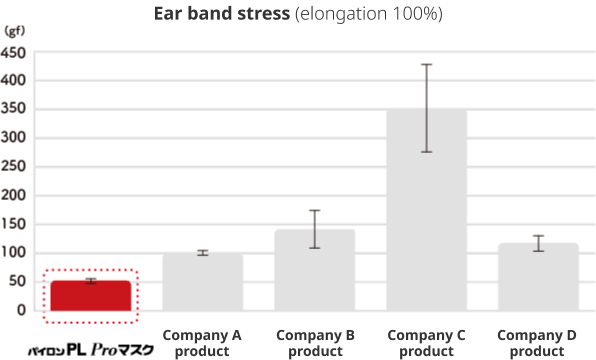
* The black line at the top of the graph represents tolerance.
(n=3)
Shionogi Healthcare
Company A product: Antiviral & antibacterial/deodorant double-protection processing mask
Company B product: Nanofiber mask
Company C product: Comfortable processing mask
Company D: 3D processing mask
Differences between PFE, BFE and VFE
PFE
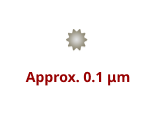
Abbreviation for Particle Filtration Efficiency
PFE shows how many particles of approximately 0.1 micrometer (μm) can be filtered (captured).
Targets include influenza viruses, single viruses (droplet nuclei), tubercle bacillus viruses, etc. The larger the number, the better the ability to filter pathogens with very small particles.
BFE
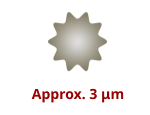
Abbreviation for Bacterial Filtration Efficiency
BFE shows how many bacteria-containing particles of approximately 3 μm can be filtered (captured).
The targets are pollen and virus droplets containing moisture associated with coughing and sneezing, etc. The larger the number, the higher the effectiveness in preventing bacterial infections and hay fever.
VFE
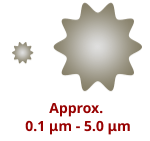
Abbreviation for Viral Filtration Efficiency
It indicates how many particles of approximately 0.1 μm to 5.0 μm in diameter containing live viruses can be filtered (captured).
The targets are influenza viruses, droplets of viruses containing moisture associated with coughing and sneezing, etc. The larger the number, the more the common viruses and droplets containing viruses can be blocked.
※1μm=1/1000mm











 in detail
in detail